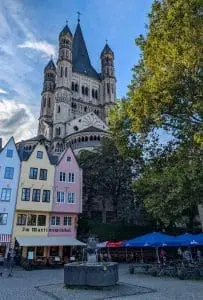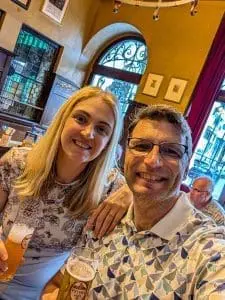 Having just returned from 2 nights in Cologne, we’ve jumped straight into writing our guide to help our readers make the most out of their trip. The popularity of Cologne has appeared out of nowhere, with many TikTokers claiming it to be the must visit city in Europe. But is it as special as it’s made out to be? As per usual we bagged a bargain with flights, so headed to Cologne or Köln as it’s known in Germany during September 2024.
Having just returned from 2 nights in Cologne, we’ve jumped straight into writing our guide to help our readers make the most out of their trip. The popularity of Cologne has appeared out of nowhere, with many TikTokers claiming it to be the must visit city in Europe. But is it as special as it’s made out to be? As per usual we bagged a bargain with flights, so headed to Cologne or Köln as it’s known in Germany during September 2024.
During our research we could tell that Cologne wasn’t going to be the big city break we were used to, which would take a number of days just to see the basics, yes Paris we’re thinking of you! Booking two nights felt like it was more than enough time to get around the main town. So, let’s dive into the medieval city of Cologne and show you what it has to offer.
Related Guide – Guide to Visiting Paris
Ad Disclaimer!
This website uses paid adverts and affiliate links, these come at no additional cost to you and help us to fund the operation of the website, meaning we can continue to provide you with valuable content.
The money received from these links and adverts do not influence any recommondations made within our content.
Page Contents
Where is Cologne and Why Visit There?
Cologne is the fourth most populated city in Germany and can be located on the western side of the country. It can be found right next to the River Rhine which is the second longest river in Central and Western Europe, after the Danube (the Rhine goes through Germany, France, Switzerland, Netherlands, Austria and Liechtenstein). It was founded in the 1st century as the Roman Colonia Agrippina, which is where the name Cologne comes from (the French version of the city’s name).
Interestingly although the city can be traced back to medieval times, including Cologne Cathedral which is the third tallest church and tallest cathedral in the world. Much of the city can be classed as modern construction with an old-world look. This is because a large portion of the city, mainly the center of Cologne, was destroyed in World War 2 due to the endless bombing by allies. By the time the American army reached Cologne in March 1945, the population of the city had reduced by 95%. Many civilians fled to more rural areas due to the sheer devastation. It was only in 1947 after Rudolf Schwarz, an architect called Cologne ‘the world’s greatest heap of rubble’, that reconstruction began. Hence why many of the buildings you will see may look medieval, but they were in fact rebuilt after the war. This includes the famous twelve Romanesque churches and Köln Cathedral.
Basically, post war Cologne is a mixture of 25% pre–World War II buildings (around 9,000 structures) and restored historic landmarks and city gates. Now you’ve had a small geography and history lesson, we’re sure you’re wondering why should I visit Cologne?
If you search this very question then you’ll find hit and miss views about Cologne, with some bloggers loving it and others advising you ‘not to bother’. We can understand both views and we’ll detail why in our summary of this guide. But if you’re intrigued as to what Cologne has to offer, then what about over 30 museums, a raft of galleries, beautiful small oldie world style streets, beer halls and Brauhaus Breweries, a gondola lift cable car and of course the jaw dropping Cologne Cathedral.
How Long Do I Need in Cologne?
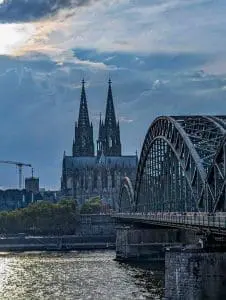 The answer to this will depend on the number of attractions you want to get done and how long you spend in each. We tend to wander through museums and galleries, but some people like to take longer and engross themselves in the artwork or antiquities etc. To enjoy a lot of what Cologne has to offer, you can pretty much fill two days with the main attractions and a little shopping on the side. But if you only have twenty-four hours available, then you’ll see most of the main sights and get a grasp of what the city has to offer. We managed quite a bit in two days, even though we were hindered by the weather.
The answer to this will depend on the number of attractions you want to get done and how long you spend in each. We tend to wander through museums and galleries, but some people like to take longer and engross themselves in the artwork or antiquities etc. To enjoy a lot of what Cologne has to offer, you can pretty much fill two days with the main attractions and a little shopping on the side. But if you only have twenty-four hours available, then you’ll see most of the main sights and get a grasp of what the city has to offer. We managed quite a bit in two days, even though we were hindered by the weather.
Where to Stay in Cologne?
Once you’ve decided on how long to spend in Cologne, you’ll be wondering where to stay. There are plenty of hotels and other types of accommodation to choose from, especially within the historic old town area. If you’re unsure where to start and it’s your first time in Cologne, then we’d recommend anywhere within a 10-minute walking radius of the cathedral, because that’s where the main attractions can be found. This area is known as Altstadt-Nord if you’re looking for something more specific for the hotel booking sites.
Altstadt-Sued is close to attractions such as the chocolate museum and the shopping area Schildergasse, but you’ll have a bit of a walk to the older prettier parts.
Deutz is across the Rhine River, and you’ll find the Cologne Triangle which is an observation tower and LANXESS Arena. Personally, unless you get an absolute bargain, we wouldn’t stay in this area. It’s a lot of additional steps to add to your day and we’re sure you can find something in your budget that’s more central.
Finally, the area of Nippes is popular for visitors who want to see the monuments and parks, including Cologne Zoo and Aquarium, the botanical garden and cable car gondolas. Even though these attractions can take up a big chunk of your day, we’d still recommend staying more towards the cathedral and either commuting into Nippes or walking. We walked along the river, and it was pretty easy and really enjoyable.
Other areas further out are Neustadt-Nord, Neustadt-Sued and Ehrenfeld, but even though they have the odd museum or attraction, they don’t cover the bulk of things to do in Cologne.
From our experience aim for the cathedral and you’ll be fine, especially as the day draws on and your feet really start to get tired.
When to Visit Cologne?
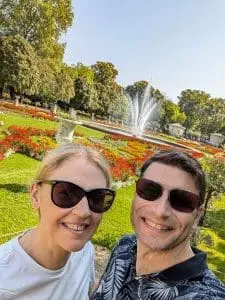 There’s never a perfect time to visit a city in Europe, but there are always better seasons. Though we firmly stand by that comment, even we got caught out during our trip to Cologne. We went at the beginning of September, which is normally a great time weather wise, but sadly we were greeted by varying extremes of weather. From insanely hot days with intense humidity, to cold and pouring with rain, then back to more heat. Bearing in mind that was over the short period of time we were there.
There’s never a perfect time to visit a city in Europe, but there are always better seasons. Though we firmly stand by that comment, even we got caught out during our trip to Cologne. We went at the beginning of September, which is normally a great time weather wise, but sadly we were greeted by varying extremes of weather. From insanely hot days with intense humidity, to cold and pouring with rain, then back to more heat. Bearing in mind that was over the short period of time we were there.
As we all know, we cannot control the weather, so the best you can do is prepare for whatever comes your way. But having an idea about the seasonal changes can give you a great start. For most people it’s difficult to travel outside of school holidays, but if you can, then we tend to recommend Spring and Autumn months as the better times to visit. April and May, or September and October are the sweet spots, mainly because the summer can get incredibly hot and make it uncomfortable to walk around.
Then add in the fact that the summer months tend to be a peak time for tourists, making it harder to get into the popular attractions. This can be a problem if you are trying to cram a lot into a short space of time. In contrast, you will find the queuing times shorter in the winter months, but the attractions may close earlier. This is why we recommend Spring or Autumn because we had light until 8 or 9pm with decent temperatures and dry days, plus the attractions were open a little later.
Hopefully you’ll get better weather than we did, because it can really impact how much you get done during your trip. If you aren’t lucky, then have back up ideas for attractions with more indoor activities such as museums. There are plenty in Cologne and they can easily take up a few hours as you let the rain pass over.
What to Pack for Cologne?
This isn’t an easy one to answer, because it will be dependent on the time of year you’re visiting Cologne. This was our first trip where we simply took rucksacks with us and in general it was fine. We didn’t feel like we needed a suitcase full of items for a couple of days city break.
For the warmer seasons we would suggest thin layers, so you can add and remove when you need to. Obviously in the winter you will need to wrap up, because it can get cold and many of the attractions are outside.
Layers are always the ideal way to go because not only will the time of year affect the temperature, but so will the time of day. It will cool as you move towards the night, so you may need a heavier jacket. Because we expected rain during our trip, we purchased this ‘Lightweight Raincoat by LUI SUI’ which ended up being incredibly handy.
Before you head to Cologne, our advice would be to Google the weather and temperature, so you can gauge what to wear. It maybe that waterproof clothing is needed and an umbrella, so it’s best to be prepared because Europe can be a little unpredictable when it comes to weather. During our trip we needed sunglasses, a hat and an umbrella, so yeah it was a little all over the place.
As you can imagine comfortable shoes are essential, because the best way to get around the city is by walking and you will get a lot of steps in, meaning it can be pretty tiring on the feet. Another recommendation is a handheld fan for those warmer days, because the humidity in the area can get incredibly unbearable. We like this ‘Jsdoin Portable Handheld USB Fan’ because it was quite powerful and helped during the intense heat, especially if you’re using the metro system there.
Other than clothes, the rest of your case will be the usual items you would take anywhere, such as medication and plug adaptors. You will find plenty of shops to buy bits should you forget anything, so don’t worry too much.
Cologne Card – KölnCard
We’re big fans of attraction passes and have used them in many cities, but you may be interested to know that Cologne also has one. Named the KölnCard this pass is ideal if you’re planning on visiting museums or the many attractions in Cologne. Rather than some of the other passes where you pay a set amount per day, and you can visit as many attractions as you want for free. The KölnCard provides discounts on many of the big activities around the city.
You can purchase the card for either 24 or 48 hours from the time it is validated, depending on the card type. The price of a single ticket is 9 Euros for 24 hours and 18 Euros for 48 hours. They also have a group ticket for five people which costs 19 Euros for 24 hours or 38 Euros for 48 hours.
We chose not to get the pass because we didn’t think we’d fit in many museums, but in reality, it covers much more than that, such as river cruises and city tours. Examples of some of the attractions include Museum Ludwig, Fragrance Museum, Chocolate Museum and the NS Documentation Centre.
If you think the attraction pass is ideal for you, then head to the Tourist Information centre in Cologne, or purchase at their public transport ticket machines known as Kölner Verkehrs-Betriebe KVB and DB. Some travel agencies, hotels and other accommodation, or tour operators also sell the card, so it’s pretty accessible around the city.
What we hadn’t realised was that in addition to giving you discount for attractions; the card also allows you to travel on public transport for free. This includes the buses, trams, suburban railway (S-Bahn) and regional trains (second class).
Aside from the transfers to and from the airport, we didn’t actually use any public transport. Again, the weather hindered us doing too much and most of the activities we wanted to see were walkable. But you may want to head out and use the rail system, so this is a great option to make it cheaper.
Getting Around Cologne – Transport Options
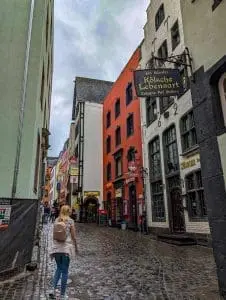 The majority of the attractions and ‘things to do’ that we will bring you, can be located within the centre of Cologne and around the Old Town. But there are a couple of activities which are a little further away, so this is when you may need to use public transport.
The majority of the attractions and ‘things to do’ that we will bring you, can be located within the centre of Cologne and around the Old Town. But there are a couple of activities which are a little further away, so this is when you may need to use public transport.
Walking
The most obvious way to get around Cologne is to walk and it’s the cheapest. Most of the attractions can be found within walking distance if you have good mobility. We tend to use Google maps and put in all the activities we want to do and follow the directions. It means we’re not wasting our time or energy getting lost, because as we all know, city breaks are tiring.
Walking is great for Cologne because you can explore the small streets, especially in the Old Town area. In reality the centre isn’t that big, so you can certainly walk the bulk of it, and you’ll be surprised by how many times you’ll spot the cathedral in the distance. It was a great anchor point for us so that we could get our bearings.
Taxis and Uber
When it comes to vehicles, we’ve started with taxis and Uber because you’ll be looking for transport from the airport. We were shocked by the cost of taxis in Cologne, because when we asked the price to reach our hotel in the centre, it was 45 Euros. The journey from the airport to the centre is about 20 minutes, so 45 Euros seems a lot. We followed signs for Car Sharing thinking this meant Uber, but it turns out that there is a separate car sharing scheme in Germany. So, after walking a while we had to turn back and go to the arrivals area and research where to get an Uber. If you book using the app, your Uber driver will pretty much pull in on the main thoroughfare at the front of the terminal. So, we walked a little further up to the area where the coaches and buses were and waited.
Within Cologne there are plenty of taxis dotted around, but we honestly don’t know what you’d need them for. If you’re not going to walk, then we’d advise using public transport instead. If the airport cost is anything to go by, we can imagine the taxi charges are expensive in general. Even the Uber cost, which is normally really reasonable, was higher than we expected in Cologne.
We chose to get an Uber to and from the airport and hotel, purely for convenience and because the weather was so hot. Next time we’d definitely use the train system instead, it is far easier and much cheaper.
Trains, Trams and Metros
We’ll start off by saying that we didn’t use any public transport during our trip. If we went back, we would use it to get to the attractions which are further out.
Cologne is well connected by public transport which includes trains, trams and an extensive metro system. The trains are known as U-Bahn (or Hochbahn) which stands for Underground, or S-Bahn which stands for Schnellbahn or ‘fast train’. The U-Bahn is indicated with a U and yep, the S-Bahn can be spotted with an S.
When you arrive by plane at the Cologne/Bonn airport, you will take the S-Bahn railway to the city centre. The journey normally takes about 12 minutes, although there is a 9-minute fast train. Trains are normally available every 30 minutes, and they are direct into the centre using either ICE or DB trains. You can purchase them in advance, which is cheaper than buying them on the day, and currently they are £8.86 (September 2024). The U-Bahn covers an extensive area of the city, but you’ll be surprised to know that even though U stands for underground, a lot of the routes are also on street level. All S-Bahn trains will run from the main station in Cologne, which is near the cathedral, but not all the underground trains will.
If you’re planning on heading out from the centre area, then you need to look at the ticket system for trains, because alike many others, there are zones which are priced differently.
Buses
When we travel, we tend to use metro systems over buses, but there is a great bus system in Cologne if you wanted to use it. Most locals don’t use buses as the stations for the trams (U-Bahn) tend to be a short walk from each other and its more convenient. Interestingly you don’t need different tickets for the tram, bus or S-Bahn, just look for the ticket machines with KVB on them. If there isn’t a ticket machine then you can purchase your ticket on the tram, which tends to be in the middle of each coach. As with the trains and trams, the bus system covers an extensive area of the city with over 76 lines being available.
Tickets for Trains, Trams and Buses
If you purchase a single ticket, then you can head to your destination without interruptions to your route. This is ideal for the one-off uses of public transport, maybe you’ve walked somewhere but your feet are aching, so you want to use public transport to get back to your hotel. If you’re planning multiple uses of public transport, then a day ticket is a better option. To give you an idea of the price difference, a single ticket can be about 3 Euros whereas the day ticket is about 9 Euros. You can buy tickets discounted on their app, in the ticket machines or in the KVB sales centres.
Hop On Hop Off Bus
Most cities have some form of hop on hop off bus, and Cologne is no different. City Tour Cologne offers the usual open top double decker buses, which follow a route around the main attractions of the city. As with the usual hop on hop off concept, you will purchase a day’s ticket which once triggered, will purely cover that specific day. So, for example if it’s triggered a 10am Monday, then you’ll have access to the bus for the entirety of Monday. You will not get access to the buses until 10am on the Tuesday, which some people get caught out on.
The route the bus will take has 15 stops, and you can get on and off as often as you like during that day. These tend to be around important attractions, so you don’t need to worry about having to walk to the next one. The bus has an audio guide which details the history of the area you’re driving through and any highlights. You could of course simply stay on the bus and just explore Cologne with your feet up. Or you could do a full circle of the route which is an hour and a half long and then use it to get to the different attractions.
The hop on hop off buses are available daily between 9am and 4pm, and covers areas such as the Cathedral, Cologne’s Altstadt (old town), the Chocolate Museum, the LANXESS Arena, Flora Botanical Garden and Cologne Zoo.
Buses such as this are ideal for people with mobility issues, and they’re a great way to discover the history of the area as you’re sat down. Depending on what you want to see when you’re there, most of the main attractions are close to each other and as such the 20 Euro cost may not be worth it. If you’re planning on heading a little further out, it may be cheaper and quicker to simply use the metro system.
We chose not to use hop on hop off buses in Cologne due to the proximity of the attractions we wanted to see, it just didn’t seem worth it. But we have used them in many other cities, so check it out and decide for yourself.
Bicycles
If you’re in mainland Europe, you expect to see lots of bikes, and they’re a common form of transport in Cologne. Thankfully unlike many cities, Cologne has lots of bike lanes which pedestrians can easily move around. But there are still areas for example the Rheingarten, where cyclists will weave in and out of the people strolling along. Of course, you can always join in and hire a bike yourself, with options such as the ‘Radstation’ being a great idea as it’s located right next to the central train station. Another option which is becoming more and more popular is bike sharing, for which you can use KVB-bicycles. They are red and white bikes which are available for anyone to use, just register with Nextbike who operate the sharing system. They will give you a code once you’ve purchased a period of time for cycling and it will open the bicycle lock. Currently the fee is 1 Euro for 30 minutes and you can rent four bikes on one account. The app is handy to have because they are used in many major cities all over the world. When you’re in the app you’ll see where the nearest bike is, or simply take one that you see on the street.
Car Sharing
We can’t imagine this will be an option you will need, but we thought we’d mention it because you will see the term ‘car sharing’ at the airport and no it doesn’t mean Uber (the mistake we made). Car sharing is similar to the bike sharing scheme above, in that you sign up with an app, validate your driving licence and pay. The company in Cologne who provides car sharing is ‘Share Now’ and they also offer electric cars. Unless you’re planning on doing a day trip somewhere much further out of the city, we cannot see a reason why you’d want to drive, but we thought we’d mention it.
Cologne Tourist City Tax
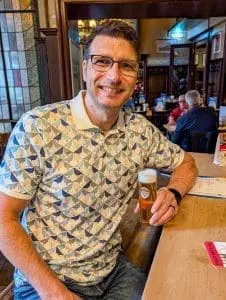 There is an increasing number of cities bringing in city taxes, and Cologne is one of them. The taxes tend to be used to improve facilities for tourists and it can vary depending on where you are visiting.
There is an increasing number of cities bringing in city taxes, and Cologne is one of them. The taxes tend to be used to improve facilities for tourists and it can vary depending on where you are visiting.
Some hotel operators will include the tax in the booking price, but the majority won’t. The tax rate is 5% of your overall hotel cost and that includes VAT, so obviously the more expensive the hotel the higher the tax. We paid about 11 Euros for two nights stay in a relatively cheap hotel, so we can imagine something plusher can really add up. The tax is collected by the hotel reception when you check in, and we paid for ours using a bank card. Business travellers were exempt until July 2024, but they too now have to pay the city tax when they stay in a hotel or accommodation.
Our List of Attractions and Things to do in Cologne Germany
So, this is probably the main reason you’ve found our guide, because you’re looking for an extensive list of attractions or activities to do in Cologne. Unlike our other guides, we’re going to do this one a little differently. Most people visiting Cologne will only do so for a 24-to-48-hour period, so we’ll focus on the main things you’ll want to get done within such a short time. After that we’ll bring you a few extras which may be of interest, but they are much further out of the centre of Cologne and as such you will need to use public transport.
Attractions For Those of You Visiting For a 24-to-48-hour Period
Cologne Cathedral
It would make sense that the first place you head to, should be the most beautiful attraction in Cologne. The Kölner Dom or Cologne Cathedral is a spectacle to behold, and it is said to be Germanys most visited landmark. What we love about the cathedral is the fact that you can see it pretty much everywhere you wander in Cologne. So, it’s a great place to base yourself near, as it’s also close to the main train station. The first thing you’ll notice is the sheer size of the building and all its intricate Gothic design. Interestingly Cologne Cathedral is the tallest twin-spired church in the world, and it became a UNESCO World Heritage Site in 1996.
So, lets delve a little into the history of the cathedral, which belongs to the Catholic Church and is the seat of the Archbishop of Cologne. They began to build the cathedral in 1248, but it was halted in the years around 1560. It wasn’t until the 1840’s that construction began again due to difficulties in finding funding. The structure was completed in 1880 and followed the original medieval design plans, with two huge towers or spires giving the cathedral the large façade that you will see.
Interestingly the original plan for Cologne Cathedral by the medieval builders was to create a grand structure which would house the Shrine of the Three Kings. The Three Kings are otherwise known as the Three Wise Men who visited Jesus Christ after his birth to bestow him with gifts. There is a gold square box at the front of the cathedral which is said to hold the ashes of the Three Kings.
As with the rest of Cologne, the cathedral suffered extensive damage during World War II. It was hit fourteen times by aerial bombs and badly damaged yet remained standing. This is incredibly lucky, especially when you consider that the rest of Cologne was basically flattened. It is believed that the twin spires were used as a navigational landmark for Allied aircraft when they flew in to bomb the city.
Repairs of the cathedral following the war were completed in 1956, with excavations being undertaken to ensure the bombing hadn’t damaged its foundations. This was completed in 1997 and led to the finding of earlier buildings on the site.
When you visit you will probably see lots of scaffolding and maintenance work being carried out. It can be a little disappointing for those of you wanting the perfect picture, but repair and maintenance work is constant. This is due to the wind, rain and pollution which discolors and eats away at the stones.
Now the history is out of the way, what can you expect when you visit Cologne Cathedral. We entered the cathedral on the side of the building, which we found a little strange. But the day after as we walked past, we noticed the front doors were open, so you may need to just wander around and see. Entrance to the cathedral is free, after all it is a working church, so bear that in mind when you’re inside. Be aware of parishioners and keep noise levels to a minimum.
As we walked in, there were staff members of the cathedral at the door, and from reading online they can conduct identity checks on occasion. Also, you can only bring in small bags and rucksacks to the cathedral, treasury and tower, no suitcases or hiking rucksacks are allowed, although we cannot imagine climbing the tower with a suitcase. The cathedral is open between 10am and 5pm on weekdays and 1pm to 4pm on Sundays.
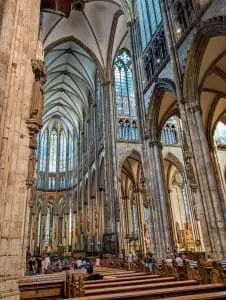 When you walk in the likelihood is your jaw will drop, because this building is HUGE! But what’s more impressive is the endless stained-glass windows which cover most of the walls. They are large and incredibly beautiful, each depicting religious symbolism. Make sure you look up at the incredible ceiling and the numerous church organs. The sound of them playing must be amazing to witness, because there were so many. There is of course the golden box at the front which contains the ashes of the Three Kings.
When you walk in the likelihood is your jaw will drop, because this building is HUGE! But what’s more impressive is the endless stained-glass windows which cover most of the walls. They are large and incredibly beautiful, each depicting religious symbolism. Make sure you look up at the incredible ceiling and the numerous church organs. The sound of them playing must be amazing to witness, because there were so many. There is of course the golden box at the front which contains the ashes of the Three Kings.
We spent about twenty minutes wandering around the church and taking it in, but also heading down to the crypt which is also free to enter.
Because of the heat we decided not to climb the tower, but if you’re interested then it’s 533 steps to the viewing platform which is about 100 meters above ground. To access the tower from the main Platz at the front of the cathedral, you’ll see a large entrance which says ‘cathedral tower/car park/toilets. The entrance to the tower is at the bottom of these steps.
The tower is ticketed with adults paying 6 Euros, children 3 Euros or you can get a family ticket for 12 Euros. Because we didn’t climb the tower, we have done some research, and the actual climb is a small two-way spiral staircase. We’ve completed numerous towers such as this and narrow staircases can be difficult to manoeuvre, especially when people are trying to get past you. The problem with the Cologne tower is that because it’s a 2-way staircase and people need to rest often, you can get stuck and have to move on. Other visitors have said it can be hard to breathe in there at times, especially in the heat, so we’re glad we didn’t attempt it as it was a 30-degree day when we visited. Once you reach the top, we’ve read that the view isn’t the greatest, which we can imagine because Cologne didn’t exactly blow us away as a city. There is a small viewing platform and a huge bell in the middle of the tower. From our research it should take you about an hour to do the climb up and down, plus the time on the viewing platform.
If this hasn’t put you off and you’re eager for the challenge, then you can buy a combi ticket which gives you access to the tower and Cathedral Treasury for 10 Euros. You can of course just purchase tickets to the Treasury which is open between 10am and 6pm and is 6 Euros for adults and 3 for children. To access the Treasury, you head through the side entrance, which was the door we entered for the cathedral. There are signs which you can follow down the stairs into a basement area. You must deposit bags because of the limited space and photography isn’t allowed.
Within the Treasury you’ll find reliquaries, liturgical utensils, manuscripts, vestments and insignia of archbishops and cathedral clergy from the 4th to the 20th century, which is presented in the converted historical cellar vaults of the 13th century. Highlights are the shrine of St. Engelbert surrounded by reliquaries and reliquiae of various saints (such as Lawrence, Sebastian, chains of St. Peter etc) and several episcopal insignia from over the centuries.
We enjoyed both the Treasury and Cathedral, but we don’t feel we missed out not doing the tower. What you do is completely up to you, but bear in mind you’re in for a long day of walking, so is it worth using up precious energy for a view that’s not that great?
Hohenzollern Bridge
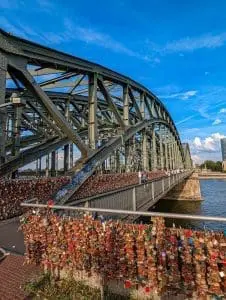 You’re probably thinking it’s weird for us to have a bridge as an attraction, but it’s actually a really popular spot for tourists and one of the hallmarks of Cologne. Located close to the Cathedral, it would make sense to head here next. Hohenzollern Bridge is a pedestrian, cycle and railway bridge which goes over the River Rhine. With multiple arches it creates a stunning view as you stroll along the Rheingarten.
You’re probably thinking it’s weird for us to have a bridge as an attraction, but it’s actually a really popular spot for tourists and one of the hallmarks of Cologne. Located close to the Cathedral, it would make sense to head here next. Hohenzollern Bridge is a pedestrian, cycle and railway bridge which goes over the River Rhine. With multiple arches it creates a stunning view as you stroll along the Rheingarten.
The Hohenzollern Bridge was built between 1907 and 1911 and consists of three side by side truss arch bridges, each with three arches. It was inaugurated by Emperor Wilhelm II and you can see the original equestrian statues of Prussian kings on either end of the bridge.
On the 06th March 1945 the German army blew up the bridge to make it difficult for the Allies to cross the Rhine. The bridge was rebuilt and opened in 1948, with two more truss arch bridges being added in 1959 and a further two in 1987.
For many visitors to Cologne the best part of walking across the 400-metre bridge is the views over the Rhine. But once you’re on the other side of the bridge (in Deutz), make sure you take a look back and enjoy incredible views of both the Hohenzollern Bridge itself and Cologne Cathedral in the background. The other popular aspect to this bridge is the thousands of love locks you’ll see which cover the railings. It’s an impressive sight and you can add a lock of your own, just keep an eye out for people selling them nearby.
Cologne’s Altstadt (Old Town) and the Rathaus (Town Hall)
Not everything you do on your trip to Cologne is about visiting attractions or buildings, sometimes it’s nice just to wander around. Thankfully Cologne provides us with the ideal area to take it a little slower. Not far from the Cathedral and Hohenzollern Bridge is Cologne’s Altstadt or Old Town. We’ll begin by saying that although many of the buildings have an old styled medieval feel, the majority were built after 1945 due to the fact that Cologne was destroyed during World War Two. But we didn’t feel that this took away the magic of the area, we still felt that European historic old-world vibe.
The old town is pretty much a stone’s throw away from the cathedral, so it makes sense to head there after. What we loved was the small streets and winding alley ways with quaint courtyards, cobblestoned paths and colourful picturesque narrow steep-gabled houses. They lead to open squares where you’ll discover a combination of the hustle and bustle of Cologne life, against the relaxed environment of locals enjoying the cafes and bars.
Altstadt is the perfect spot to head if you’re looking for food and drink, because there are so many options to choose from. If the weather is good then make sure you sit outside, because it’s the perfect place to people watch and really absorb the feeling of being a local. We spent a good hour meandering around and spotted there were quite a few walking tours, which you can prebook online.
Within the old town area, you will find Germany’s oldest town hall known as the Rathaus. It is more than 800 years old and consists of the main building, the town hall tower which is beautiful, the Renaissance arbour in the front and an attached administrative section. Sadly, there was a lot of building work when we visited so we didn’t enjoy the full impact of the front of the building, but the tower alone is impressive.
One of the Instagram pictures which caught our eye of Cologne, was a distance picture of a beautiful Platz with a row of colourful houses and a grand church in the background. The church is in fact the Great St. Martin Church which can be found in the Old Town of Cologne. It was founded around 960 AD on the remnants of a Roman chapel and built between 1150 and 1250. The architectural style used is called trefoil which basically means 3 apses, and when you take in the massive tower it is quite an imposing sight.
The current building is dedicated to Saint Martinus and the interior is almost bare. We didn’t go into the church because we had been told there’s not much to see and it’s not worth the time. If you want to go in then it’s free, just check online for opening times because they will vary, but the church is closed on Mondays. Although there is little inside, you will see floor mosaics, a 16th century crucifixion group, a 16th century Christ burial group, a Triptych from 1530 and a 17th century Russian icon.
As with the rest of Cologne, the Great St. Martin Church was badly damaged in World War Two, with the tower, chapel and nave being completely destroyed. Restoration began after the war with the church being rebuilt following the original designs. It was completed in 1985 and although we didn’t think much of the front of the building, make sure you head down to the river and look at it from the back because it’s beautiful.
Rheingarten
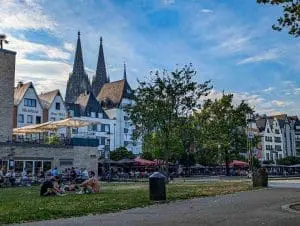 Right next to Great St. Martins Church is the Rheingarten which is a paved promenade between the Lindt Chocolate Museum and Hohenzollern Bridge. It’s a heavily used pedestrianised area by locals for either relaxing, strolling or commuting to various locations in the city. Along the way there are well kept green areas, lots of bars, cafes and restaurants, as well as hotels, so it’s another great spot in Cologne to base yourself out of.
Right next to Great St. Martins Church is the Rheingarten which is a paved promenade between the Lindt Chocolate Museum and Hohenzollern Bridge. It’s a heavily used pedestrianised area by locals for either relaxing, strolling or commuting to various locations in the city. Along the way there are well kept green areas, lots of bars, cafes and restaurants, as well as hotels, so it’s another great spot in Cologne to base yourself out of.
Museum Ludwig
This modern art museum is located between Cologne Cathedral and Hohenzollern Bridge, so it’s quite centrally located. It offers a diverse range, from Pop Art, Abstract and Surrealism, but it’s also home to one of the largest Picasso collections in Europe. Even if you’re not an art expert you will recognise some of the artists in Museum Ludwig, such as Andy Warhol and Roy Lichtenstein.
Much of the artwork, over 350 pieces were endowed by Peter Ludwig, hence the name of the museum. But additional donators have since added to the collection with artists such as Erich Heckel, Karl Schmidt-Rottluff, Otto Mueller, Hockey Polke and Marc Chagall being displayed. As we mentioned above, if you’re a Picasso fan then you’ll enjoy seeing around 900 works, making it the third largest collection in the world.
Museum Ludwig is also the home to 70,000 photographic works of art, which provide an insight into the origins of photography to the present day. The exhibition is an impressive cross section of art from the last one hundred and twenty-five years.
We love having some museums on our list of attractions because it’s nice to head inside at times. If the weather isn’t the best, then you can escape out of it for a while and take in the beautiful artwork. Museum Ludwig is open between Tuesday and Sunday from 9am to 5pm, but they are closed on Mondays. The cost to enter is 11 Euros, which is quite reasonable for the size of the collection on show and even more so because of the Picasso exhibit. How long you spend in there is completely up to you, but there is enough to see that you could easily spend a few hours strolling around.
Church of Ursula
Ironically this church was across the road from our hotel, but every time we went over it was closed. So sadly, we can’t give you information from a personal perspective. We didn’t think that much of the outside of the church, but we have read that the inside if beautiful and has an impressive stained-glass window.
St Ursulas tomb can be found in the church and is topped with a beautiful marble sculpture. The story behind St Ursula is an interesting one and revolves around Ursula a Roman-British Princess, who legend says in the 300’s went on a Pan-European pilgrimage. She is said to have sailed with 11,000 of her virginal best friends, and yes, we can imagine you’re rolling your eyes imaging a boat which can hold so many people and even knowing 11,000 virgins. If all this doesn’t sound ridiculous enough, then how about the fact that a freak storm is said to have blown the ship to Rome in a single day. Ursula convinced the Pope and other religious figures to join her on the pilgrimage. Everything was fine until they reached Cologne and were captured by the Hun. Ursula was shot dead, and the other virginal passengers were beheaded.
In 1155 a mass grave was discovered in the area, and it was claimed that they were Ursula and the virgins, with the Church being the gravesite. Although the Church of Ursula was already dedicated to the befallen princess, it was expanded to make room for the martyred virginal bones that had been discovered. This part of the church is called the Goldene Kammer (Golden Chamber) and it’s a reliquary filled with head busts containing skulls, arms, ribs, femurs and so on. You may have to ask an attendant to let you in as it will be kept locked. Reviews of the Golden Chamber say that once you get past the fact that it’s made of bones, it’s quite pretty.
Entering the main church is free and even though we didn’t manage to get in, they do have set opening times which are Monday to Saturday between 10am and 12pm, then from 3pm to 5pm. On Sundays they are open between 3pm and 5pm because as you can imagine this is a working church, so there will be parishioners and sometimes the church maybe closed for weddings or funerals.
Rhine Boat Tour
We’re going to mention Rhine Boat Tours but again we’ll admit that we didn’t go on one, but not for the want of trying. We quite like doing boat tours whenever we head to a city, because it gives us the chance to rest our weary feet and take in the views from another angle.
The first problem we had was trying to find a tour, because most of boats were huge and definitely not for short trips up and down the river. We even Googled it and still had a tough time working out what to book. On our last day as we walked back from the Zoo and Botanical Garden, we spotted a couple of small huts on the other side of the Hohenzollern Bridge, which looked more like the thirty minute or an hours tour we were accustomed to. So, our advice is to continue to walk up the Rheingarten under the bridge and you should spot them, even though there were only two companies. They seemed to leave every 30 minutes and the cost on the board was 17 Euros.
Bearing in mind the cost, we will add that we’re not sure what sights you’d see on the boat tour. Most of the attractions and main sights are away from the river, so you’re really just viewing the promenade or buildings. In all honesty we’re not sure it’s worth the cost, but then again, we didn’t go on one to have an opinion. It’s best you just gauge yourself as to whether you want to spend the money or not.
Koln Triangle Observation Deck
When you see the words Köln Triangle, an observation deck isn’t the first thing you would think about. But this building provides some incredible views over the old town area of Cologne, so let’s start off by telling you where it is.
During our first day we wandered across the Hohenzolleron Bridge over to the area of Deutz. You will see the tall building where the Koln Triangle is located in the distance. Once you’ve walked over the bridge, then head along the riverside until you reach Hermann-Pünder-Straße. If you then turn left and walk down that street, you will soon come upon the Koln Triangle on your left near a small square. Look for a yellow art installation pillar with a water fountain and then keep walking left and you see a door for the attraction and a red pillar stating Cologne View.
The best part of the observation deck is that it offers a unique view of the city, but we’d recommend walking around areas such as the old town and the cathedral first. Mainly because the Triangle offers you a different view from somewhere you’ve already been.
The entrance fee is only 5 Euros for adults, and once you’ve paid you will take the lift to the 29th floor to the observation deck. Once at the top you can enjoy a 360-degree view of Cologne including the Cathedral, Old Town and the Rhine. The observation platform is fully secured with large windows, and you have drawings telling you what buildings you are looking at. You can easily spend an hour up there and it’s an especially beautiful spot if you go later in the day as the sun is setting over such a vibrant city.
Koln Triangle is open between May and September, Sunday to Thursday 11am to 8pm, then Friday and Saturday are 11am to 10pm.
EL-DE Haus NS Documentation Centre of the City of Cologne
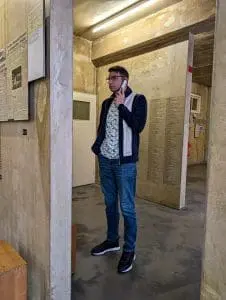 We headed to this museum on the second day of our trip, not quite knowing what to expect. Thankfully it was raining outside so this was a great way of getting into the warmth. The EL-DE Haus isn’t your a-typical museum, so it can be difficult to work out if you’re actually at the right place. We’ll provide a bit of background as to what the museum is about, before we go into our experience.
We headed to this museum on the second day of our trip, not quite knowing what to expect. Thankfully it was raining outside so this was a great way of getting into the warmth. The EL-DE Haus isn’t your a-typical museum, so it can be difficult to work out if you’re actually at the right place. We’ll provide a bit of background as to what the museum is about, before we go into our experience.
What was a former Gestapo headquarters in Cologne from 1935 to 1945, is now a Nazi-victim memorial centre with exhibits over two floors and a basement jail. It’s also Cologne’s National Socialism Documentation Centre which links the commemoration of the victims of the Nazi regime, to the exploration and portrayal of Cologne under Nazi rule.
Entry to the museum is only 4.50 Euros for adults and they are open Tuesday to Friday from 10am to 6pm, and then on Saturday, Sunday and public holidays it’s 11am to 6pm. When we arrived at the ticket desk, we were asked if we wanted to pay for an audio guide. Unless you speak German, our advice is to pay for the guide, it’s only 2 Euros and we think the museum would be pretty impossible to understand without it. We were then advised to head upstairs to the first floor of the museum, and we can understand why, but we wouldn’t recommend you do that.
Although the museum generally looks like empty rooms, there is in fact a huge amount of information to take in through the audio guide. This museum is starting before the war and going through it all, which is a lot and can take hours if you listen to everything. We’ll admit that we got to the point of skipping bits after being in there for two hours. There are two floors the same size and they cover different aspects, such as the start of the war and the various departments of the Nazis. As well as the impact on Jewish citizens, the LGBT community and disabled citizens in Cologne. The heartbreak of hearing how people were forcibly sterilised, even children, will never leave us.
The main reason you’re probably there is to learn about the Gestapo and their impact on German citizens, so to really understand that we’d recommend heading to the basement first. It’s daunting to see the cells, because they are reminders of the atrocities which happened to everyday citizens during a horrific period of history. The prison is one of the best-preserved detention sites of the Nazi era, you can even see hundreds of inscriptions of names on the cell walls. These people were persecuted, tortured and murdered in those cells, under the name of Naziism. Our recommendation to go there first is purely down to the length of time it takes to walk through the permanent exhibition on the first and second floor. You’ll have to balance out how long you want to spend there, because you literally could be there all day.
We did as told and went to the first floor and listened to every section of the audio guide and by the time we finished the first floor, a couple of hours had disappeared. Because of the fact we were only in Cologne for a couple of days, we knew we couldn’t spend hours just in the EL-DE Haus Museum. So, we sped through the second floor and possibly missed some really interesting sections.
You may have far more time than us to work through it all, but by the time we got to the end of the exhibit we were a little tired and ready for a break. This means we didn’t spend as long as we possibly should in the prisons, which is why we’d suggest doing it the other way round.
Interestingly the look of the permanent exhibition is deliberate, because they wanted to give it an authenticity of how it would have looked at the time.
Hopefully we’re not putting you off from going by saying it takes a while to get around, because we really found our time there interesting. We always feel like we know everything about WW2 and yet we are endlessly learning new things, and here there were so many facts we didn’t know. Keep an eye out for a ballot card from Germany during the war, it’s insane to believe it’s even real.
Related Guide – Guide to Visiting Auschwitz-Birkenau
Time Ride VR Cologne
We’ll be honest and tell you that we didn’t get chance to do the Time Ride VR in Cologne. Although it’s incredibly close to the old town, in fact it’s right near the Great St. Martin Church. But we had so much to do in a short amount of time and had to be picky.
Because we want to bring you everything that is available in Cologne, we’ll still provide you with information about the VR Ride from our research. The VR Cologne is a great way to immerse yourself in the Golden Twenties. The attraction takes about 40 to 45 minutes, and you’re transported back to 1926, with the help of a charming hat maker and a Cologne streetcar driver.
The 3D tram experience is available in both German and English and will take you through various parts of history including the end of the First World War, the British occupation and Spanish Flu. It even includes archive footage of Cologne from the 1920’s, which is great to compare to the city you see today.
The ride is open every day between 10am and 7pm and ticket prices will vary depending on the day of the week. They do advise booking online early to secure the cheapest ticket on your preferred date. But the average price is 16.90 Euros for the TimeRide Senseum Cologne, 29.90 Euros for the TimeRide GO! Cologne which takes 90 minutes and 19.90 Euros for the TimeRide GO! Cologne Cathedral 360.
The reviews we have seen for this are very hit and miss, we think it depends if you have the available time, money and you tend to like VR attractions such as this.
Schildergasse Shopping Centre and Neumarkt Galerie
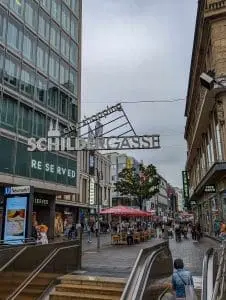 Although we love seeing attractions around the world, we must admit that we do enjoy a bit of shopping if we have the time. We love to buy clothes in different countries because when we wear them in our everyday life, we remember the trip we bought them on.
Although we love seeing attractions around the world, we must admit that we do enjoy a bit of shopping if we have the time. We love to buy clothes in different countries because when we wear them in our everyday life, we remember the trip we bought them on.
In Cologne you have the Schildergasse Shopping Centre, which is a shopping district or pedestrian street with all the top brands you can find in most big cities. It reminded us of Manchester in England, although that may have been because we visited when it rained.
You then have Neumarkt Galerie which is basically a big shopping centre with the focal shop being Primark, but who doesn’t love Primark.
Cologne Fragrance Museum
Of course, when we see the word Cologne, we generally connect it to perfume or fragrances so it would make sense that there is a Fragrance Museum in the city. The museum is only 8 Euros, and you can visit between Monday to Saturday from 10am to 7pm or Sunday 11am to 5pm (there maybe seasonal changes).
Unlike many museums where you can wander on your own, the Fragrance Museum involves a tour guide. They will help you immerse and get swept away in the wonderful world of perfumes, by looking at the three centuries of fragrance and cultural history. This begins with the Rococo era around 1685 to 1766, which was the time of the Italian perfumer Johann Maria Farina. His business is the world’s oldest fragrance manufacturer, and its headquarters are the location of the museum.
Your tour guide, dressed in historical costumes will welcome you into the sensory experience and delve into the history of the original perfume. Interestingly Napoleon used up two whole bottles of it every day, which must have been quite pungent. The tour will involve smelling essences as you find out the process of making perfume, such as enfleurage.
Once you’ve finished the tour there is a shop to buy yourself a lovely treat, but bear in mind that you are given a small bottle of perfume at the end which equates to the same cost of your tour. This is the perfect attraction for those bad weather days, but it’s such a great price that it makes sense to add it to your Cologne activity list.
Attractions in Cologne a Little Further Out of the Old Town
That’s all the attractions which are close to the Old Town area of the city, so if you’re staying close to the Cathedral and you only have 24 hours in Cologne, then that’s a great list for you to get through.
We’ll bring you a few attractions which are a little further away, so you’ll have a 30-to-40-minute walk, or you could use public transport such as the trains and buses. It may be that you like the sound of these, so you will forgo the closer ones, which we completely understand. Some of these attractions were our favourite things to do during our trip, and we found that the walk wasn’t too excessive.
Rhein-Seilbahn Gondola Ride
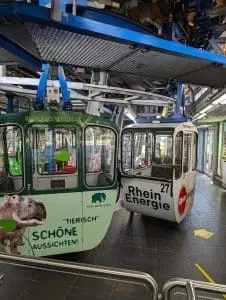 We’ll start by saying that this was one of our favourite attractions during our time in Cologne. It’s basically a cable car which goes over the River Rhine and the Zoobrücke (Zoo bridge) road, but you’ll enjoy great views as you travel. This attraction opened in 1957 and is popular for both locals and visitors. There are 44 cable cars, each decorated with a different motif.
We’ll start by saying that this was one of our favourite attractions during our time in Cologne. It’s basically a cable car which goes over the River Rhine and the Zoobrücke (Zoo bridge) road, but you’ll enjoy great views as you travel. This attraction opened in 1957 and is popular for both locals and visitors. There are 44 cable cars, each decorated with a different motif.
The gondola ride is only about 5 minutes each way at a relaxing speed of 10 km/h, and you can choose to either go one way or enjoy a return trip. We decided to pay for the return trip, which was 9 Euros, but a single ticket is 5 Euros. There is a combo ticket available which combines the gondola, zoo and aquarium which is currently 27.50 Euros.
We started our journey from the ticket office close to the Cologne Zoo and botanical gardens. When we arrived at the ticket office you purchase your choice of ticket and then they will direct you through a gate. You will need your ticket to scan through a barricade, and then a worker will help you into the gondola. After that it’s up, up and away as you climb up to around 50 meters in the air. There is a slight rock to the cable car on occasion, but it’s nothing too severe that it bothered us. You begin to head over the Rhine and it’s here you’ll see the old town to the right including the Hohenzollern Bridge and Cologne Cathedral. The gondola then continues over the Zoobrücke road and then you’ll see park areas and move over a swimming pool and spa. We will prewarn you that the swimming pool area may create a little shock and a giggle, because it’s a nudist pool so you will see a lot of; well, we’ll leave that to your imagination. I mean we’re British, so we have been known to be a little prudish, but nudity is seen as completely normal in Europe. None of the clothesless swimmers and sunbathers seemed at all phased by the endless cable cars streaming over the pool area.
As you get to the end of the ride, a worker will ask if you’re heading back over or getting off. Of course, if you’re getting off, they will open the door of the gondola for you. If not, then you head back over and enjoy the views from the other side. We then jumped off at the place we started and enjoyed the rest of our day.
The only thing we will say is that it was incredibly hot on the day we went on the Rhein-Seilbahn Gondola Ride, and it felt worse in there because there are only tiny windows, and you’re surrounded by glass. This is just something to bear in mind, especially if you’re travelling with children.
The cable cars hours will varying depending on the time of year, but generally it’s open March to October from 9.30 to 6 or 7 o’clock. If you’re planning on visiting the Rheinpark then the gondolas are handy to get from the zoo area to the park.
Flora und Botanischer Garten Köln – Colognes Botanical Garden
After we finished at the cable car, we headed over to the botanical gardens which was only a five-minute walk away. The gardens are free to enter and they’re open daily between 8am and 9pm.
You walk in through large, beautiful gates and are met with a stunning building in the background, ornate water feature and masses of flowers and trees. This is just a small section of the 5.5 hectares of land in the gardens, which are home to 12,000 species of plants from all over the world. Each section features different styles such as English landscape, Italian Renaissance and French Baroque. We know that you’ll be short on time when you visit Cologne, but we’d recommend taking a moment of your day to slow down and take a stroll around the gardens. Enjoy the shaded arcades, beautiful waterfalls, ponds, springs and fountains, with huge ornaments from Greek mythology. We were amazed to see huge redwood trees and an iris garden, as well as a small alcove filled with fuchsias.
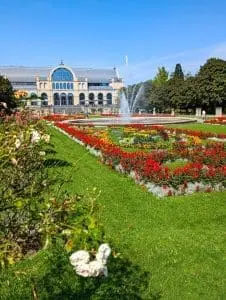 There are two huge greenhouses which are home to plants and flowers from areas such as the Amazon and desert. Such specialised plants need specific climates which are easier to control in the greenhouses. Sadly, for us, both were closed to the public and as such we didn’t have the opportunity to go in. If you’re lucky and get to visit the subtropical greenhouses then take a look at the camelia collection, as well as the 400 species of plants, some being more than one hundred years old.
There are two huge greenhouses which are home to plants and flowers from areas such as the Amazon and desert. Such specialised plants need specific climates which are easier to control in the greenhouses. Sadly, for us, both were closed to the public and as such we didn’t have the opportunity to go in. If you’re lucky and get to visit the subtropical greenhouses then take a look at the camelia collection, as well as the 400 species of plants, some being more than one hundred years old.
There are free public toilets available, a garden café (Dank Augusta) and restaurant (The Glass Palace) where you can grab a drink and bite to eat. We spent between an hour and two hours in the Flora Botanical Garden, and we really enjoyed it. It was a nice change from the city area and gave us the opportunity to slow down for a bit.
Kölner Zoo and Aquarium
This is another attraction we sadly didn’t get the opportunity to do, simply because we didn’t have the time. The zoo is close to the Rhein-Seilbahn Gondola Ride and Botanical Garden, so it’s perfect to tie them all in together. Opening hours for both the aquarium and zoo will depend upon the time of year, but in the summer it’s 9am to 6pm and in the winter 9am to 5pm. Ticket prices are 23 Euros for an adult, but make sure you check online to see any seasonal prices.
The zoo is the third oldest in Germany and has over 10,000 animals of more than 850 species. The area of the zoo is 20 hectares so yes there will be lots of walking. There is an attached aquarium, a great ape jungle house, a rainforest hall which houses animals native to Southeast Asia. There’s also an Asian elephant park, hippo and crocodile house, and so much more!
From our research the zoo is quite large with lots of beautiful landscaping. Once you purchase your ticket, you are given a map to the various areas and told when the feeding times and shows are. There are various feeding shows through the day for different animals which include penguins, sea lions, hippos, baboons and meerkats.
The aquarium and terrarium section offers a huge diversity of fish and marine life from all over the world. They have an underwater tunnel which helps immerse you into the world below. Part of many of the shows are interactive with educational experiences, and there is educational signage about many of the animals.
If you’re looking for food then there are lots of amenities such as cafes and snack bars, or you can bring your own and use their picnic spots.
Advice online is that you should arrive early to make the most of the zoo and so you can see the animal feedings and shows.
Ebertplatz Station Slide
Ebertplatz Station is the largest underground station in Cologne, but we’re not sending you there to look at trains. Within the station is an art project known as the ‘Silver Surfer’, but the best part is you can take part. What was an escalator has been made into a slide, so you can get to your train by sliding down the Silver Surfer instead of using the stairs. How much fun would that be getting to work every day, instead of the same old monotonous stairs.
The station is about a 16-minute walk from the cathedral, so it’s a little further out from the old town, but still walkable if you like to get your steps in.
Mustard Museum – Senfmuseum – CLOSED
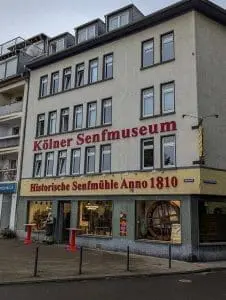 During our trip to Cologne, we made our way down to the Mustard Museum, which was about a 15-minute walk from the old town. We walked in and basically found ourselves in a mustard shop and couldn’t see any information about the museum. So, we ended up walking back out again and heading back up the same street we had literally just walked down. What we didn’t know is that the Mustard Museum is now closed, and they are now simply a mustard shop. We debated about leaving this item off the list, but because it’s on so many other bloggers pages, we wanted to give you a heads up, so you don’t waste your time like we did. The shop is across the road from the Chocolate Museum so instead why not head over there.
During our trip to Cologne, we made our way down to the Mustard Museum, which was about a 15-minute walk from the old town. We walked in and basically found ourselves in a mustard shop and couldn’t see any information about the museum. So, we ended up walking back out again and heading back up the same street we had literally just walked down. What we didn’t know is that the Mustard Museum is now closed, and they are now simply a mustard shop. We debated about leaving this item off the list, but because it’s on so many other bloggers pages, we wanted to give you a heads up, so you don’t waste your time like we did. The shop is across the road from the Chocolate Museum so instead why not head over there.
There are opportunities to taste the mustards, and they sell freshly cooked bratwurst. But as with many dedicated food shops, the prices are a little high.
Chocolate Museum – Schokoladen Museum
Across the road from the Mustard Museum is the Lindt Chocolate Museum, which offers both history and samples of their sweet treats. There’s even a three-metre high fountain with 200 kilograms of chocolate which constantly flows, and you can sample.
During your time in the museum, you’ll enjoy discovering about the cultural history of chocolate which goes back around 5,000 years. There’s plenty to read about the chocolate making process and its history, from the ‘ambrosia’ of the gods to the Aztecs, to the Columbian cultures of Central America, all the way through to the current day where it is a heavily industrialised product.
During this ‘trip around the world of cocoa’ you’ll enjoy learning through a variety of formats, with many digital and interactive stations. But we especially enjoyed the walk-in tropical glasshouse with a cocoa tree and tropical climate. They even have a glass fronted factory section, which was very reminiscent of the Cadburys tour, where you can watch chocolate bars being made.
The Chocolate Museum is bigger than we expected and made our trip to Cologne more memorable. We enjoyed the history, but of course it was the tastings which really made our day, with small samples being available throughout. There is a big gift shop where you can buy some sweet treats to take home, and you can even design your own chocolate bar with a range of flavours and fillings. They even have a restaurant called CHOCOLAT Grand Café which serves delicious cakes, crepes, waffles and chocolate specialities in their panorama restaurant with views over the Rhine.
If you fancy treating yourself then you could book a guided tour, such as ‘100% Chocolate’ or ‘Little Chocolate School’. You’ll not only learn more about the world of chocolate, but you can try more samples.
Tickets for adults to the Chocolate Museum are 15.50 Euros, and they recommend you prebook as it is one of the most popular attractions in Cologne after the cathedral. If you prefer to just turn up, then it may be best to head there early morning, or late afternoon when there are fewer visitors.
The museum is open daily from 10am to 6pm, but there are alterations to this depending on the season, so we recommend checking on their website. Depending on how in-depth you want to go, it can take between one and two hours to look around the museum.
Attractions in Cologne Where You’ll Need Public Transport
Finally, we bring you a couple of attractions which are much further away from the centre of Cologne and as such you will need to use some form of transport to get there. Unless you’re in Cologne for a few days or you really like the sound of these attractions, then we’d recommend sticking with the closer activities. But you know we like to bring you everything, so here they are.
Memorial to the Edelweiss Pirates
The memorial is a 50-minute walk from the cathedral or 10 minutes by metro, so it would make sense to use public transport and save your legs. The plaque or mural which is in German can be found under the Ehrenfeld railway bridge, and it commemorates the heroic group known as the Edelweiss Pirates. They were a youth subculture that emerged in the 1930’s as a response to Nazi totalitarianism and the indoctrination of children and teenagers into Hitler youth. Edelweiss Pirates stood in contrast to the Hitler Youth and advocated freedom of expression through music, art, dance and dress.
But don’t think this meant that they were pacifists, because there are many stories of Pirates ambushing Hitler Youth patrols and meetings, and brawling with them on the streets in many of Germanys major cities.
By the time World War Two started, the Pirates activities escalated to sabotaging railways and munition factories. But also giving shelter to escapees from concentration camps, army deserters and assisting the spies and allies.
In 1944 after the Pirates assassinated a Nazi informant and their plans to blow up the Gestapo headquarters in Cologne was discovered. Himmler issued orders to infiltrate and arrest the groups ringleaders. Many were found and tortured, or sent to concentration camps, but to scare people from joining the group they publicly executed 13 of the ringleaders under the railway where the mural now stands.
This is a brief attraction time wise, but it’s important to remember the importance of its history, knowing that there were many Germanys fighting the tyranny of the Nazis.
Belgium Quarter – Belgisches Viertel
Sometimes it’s nice to simply stroll around a part of the city you’re visiting. So, we thought we’d mention the Belgium Quarter in Cologne, otherwise known as Belgisches Viertel. This district is about a 25-minute walk from the cathedral, so a little further out from the other activities and attractions.
Why head there? Well, it’s quite a trendy and popular part of Cologne, bearing in mind that Belgium is just over an hours drive from the German city. There is plenty to see and do including designer shops, lots of restaurants, incredible nightlife and fabulous Art Nouveau buildings.
Lindenthaler Tierpark
Lindenthaler Tierpark is a 100-year-old park where animals such as fallow deer and sheep, can eat out of your hand as they roam freely. This park is open from 7am to 7pm, and it’s a beautiful experience of connecting with animals in their natural habitat. As well as deer and sheep you can see domestic fowl in a walk-through aviary and there is a petting zoo with goats and donkeys.
Best part of this is that it’s completely free to enter, but it’s over an hours walk from the cathedral or 30 minutes on public transport. This can take up a big chunk of your day, so you need to work out if it’s how you want to spend your time.
Cologne Museums
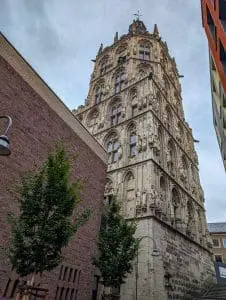 We’ve mentioned a few of them in our list of attractions, but Cologne has so many museums that this article would feel endless. So, we’ve decided to pick out the main ones with a small summary of what it is, so you can delve further if you’re interested.
We’ve mentioned a few of them in our list of attractions, but Cologne has so many museums that this article would feel endless. So, we’ve decided to pick out the main ones with a small summary of what it is, so you can delve further if you’re interested.
- Kolumba – Art Museum of the Archdiocese of Cologne.
- Cologne City Museum – Exploring the city and bringing it to life.
- Museum Schnütgen – Medieval art on exhibit in one of Cologne’s oldest churches.
- German Sports & Olympics Museum – Various aspects of all kinds of national, international and Olympic sports.
- Museum of East Asian Art – Houses the most significant collection of East Asian art from China, Korea and Japan.
- Tram Museum Thielenbruch – Learn about the history of local public transport in the Cologne region.
- Archaeological Zone – Jewish Museum – Impressive relics of Colognes Roman past.
Our Cologne Top Tips
Prepping for your city break is important so that you have everything you need. Here are a few tips to make your time in Cologne more comfortable.
- Wearing comfortable shoes is a must – You’re going to spend most of the day on your feet, either walking or standing. It would make sense to make sure the shoes you wear are comfortable. They can also get pretty dirty, so it’s worth taking shoes which you don’t mind getting mucky or battered. We always travel in our comfy trainers and even they can leave our feet feeling sore at the end of a long day.
- Think about the weather – We’ve mentioned this already, but preparing for the weather in the place you’re visiting is essential to make it comfortable and enjoyable. Europe can be incredible hot in the summer, but also have heavy rainfalls thrown in. This is why you should prepare for anything, and by that we mean wet proof gear, umbrella, sun hat and sunglasses. Once you’ve checked the weather apps, you’ll have a better idea of what to take with you. Ironically, we needed it all, with one day being a heatwave, the next rainstorms and then the final day back to a heatwave.
- Use trains or Uber over taxis at the airport –We were shocked by how expensive taxis were in Cologne, even Uber was much higher than major cities we have visited. If you can, use public transport such as trams, buses and trains.
- Work out your priority’s attraction wise – If you’re staying in Cologne for a short period of time, then you really need to consider what things you want to do first. Bear in mind that some attractions may be closed earlier than others, or shut on specific days, so make sure you do your research or keep our guide handy.
- Beware of bikes – Yep, you’re in Europe and that means one thing, lots of bikes. If you’re not used to it, you can get a little complacent which could lead to an accident. We nearly collided with a bike as we crossed a road in Amsterdam once, purely because we didn’t realise how much they speed around. Bikes take priority, so as a pedestrian we just have to manoeuvre around them.
- Drink Kölsch Beer at a traditional German Brauhaus – You’re in Germany so it would seem rude not to stop and enjoy a beer or two. Why not head into a traditional German Brauhaus and take in the atmosphere. We visited a couple during our trip and interestingly the beer size is really small and not the huge stein we expected. If you’re a pint drinker, then you may want to order a couple of them because they go down quickly. We sat inside for the first Brauhaus and outside for the second and we must admit that it was nicer outside watching the world go by. Popular Brauhaus’s in Cologne’s old town area are Peters Brauhaus, Sion Brauhaus, FRÜH Brauhaus and Gaffel am Dom. These are all in close proximity to the cathedral and prices are generally the same, with us paying just over 2 Euros for a small beer.
- Just stroll – There are so many things to see in Cologne, that you can end up pounding the streets and missing the scenery. But it would be a shame if you didn’t slow down for a bit and simply stroll. This could be along the Rhine promenade or around the old town. Remember there are twelve beautiful Romanesque churches in Cologne to discover.
- Try traditional Kölsche cuisine – Head to a brauhaus to try the local cuisine, whether its Halver Hahn (cheese with a bread roll), Himmel un ad (black pudding, mashed potatoes, fried onions, and apple sauce), Sauerbraten (vinegar marinated beef cooked in a stew) or Rievkoche (potatoes fried in wheat flour with onions and served with lingonberries).
Should I Visit Cologne?
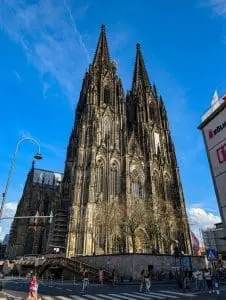 We have very mixed feelings on this, so we’re going to be honest with you, as we always try to be. Remember that this is from our perspective and other travel bloggers may feel completely differently to us, so read around and then make a judgement call. We paid very little for our flights and hotel, but we got a great location not far from the cathedral. The main problem with our trip was the weather. On the day we arrived, it was full on heat wave with high humidity, then the day after it rained the entire day. To top it off, on the final day when we were due to fly home, the heat ramped back up to a scorching 30 degrees (again with intense humidity). This can make it really difficult to get around and do the activities you want, but also to simply appreciate the place you’re in. So, we want to be transparent and say that this may have jaded our views of Cologne.
We have very mixed feelings on this, so we’re going to be honest with you, as we always try to be. Remember that this is from our perspective and other travel bloggers may feel completely differently to us, so read around and then make a judgement call. We paid very little for our flights and hotel, but we got a great location not far from the cathedral. The main problem with our trip was the weather. On the day we arrived, it was full on heat wave with high humidity, then the day after it rained the entire day. To top it off, on the final day when we were due to fly home, the heat ramped back up to a scorching 30 degrees (again with intense humidity). This can make it really difficult to get around and do the activities you want, but also to simply appreciate the place you’re in. So, we want to be transparent and say that this may have jaded our views of Cologne.
Overall, we had a nice trip, bar the weather, but in all honesty it won’t be the most memorable place we’ve ever visited, and we wouldn’t go back. Would we recommend it to our friends? Not unless they got really cheap flights and there wasn’t anywhere else they fancied. There are cute parts to wander around, more specifically the old town of Cologne which we enjoyed, but as for the rest of the city it’s pretty non-descript.
Probably the most stand out part of the city is the impressive Cologne Cathedral; we must admit we didn’t get tired of seeing this gargantuan beautiful building which towered over the city. It felt like you could see it in the distance wherever you walked in Cologne, it was simply that big. But it was the inside of the cathedral which will leave a lasting impression, with endless stained-glass windows.
For us there was plenty to do in a 24-hour period, especially if you’re just going to the centre of Cologne. Many bloggers and TikTok videos will show you attractions which are further out and as such you need to use transport. We simply didn’t have to time to fit them in but have added them to the guide as they are things you may want to do.
Walking around the centre of Cologne felt safe enough, although you have the usual big city problems. We didn’t venture out at night-time because of the weather, but we can imagine it may feel a little intimidating.
There are quaint European vibes though, and we enjoyed sitting outside a café in one of the many ‘Platz’ or squares. We went to a couple of the recommended traditional Brauhaus, but they didn’t really seem any different from the other restaurants or cafes.
One of the other things we noticed was how much more expensive Cologne was to other European cities we have visited. We were shocked at the cost of taxis and Ubers from the airport, even though it’s one of the shortest distances we’ve ever done. Even food and drink felt pricier than we expected, especially when you consider a few months before that we had been to the Amalfi Coast which is notorious for being expensive, but we felt it wasn’t too bad.
Related Guide – Our Guide to Travelling Around the Amalfi Coast and Campania Region
So, what does this mean for you? Well, if you’ve already booked then we’re sure you’ll have a good time and hopefully with our list of attractions you’ll have plenty to do. But would we jump at the chance to go again, no sadly not. We have been to Berlin before and fell in love with it, but Cologne didn’t offer the same feeling. It may be that the weather impacted our views, but we’re not sure we’d have felt massively different if it had been a more temperate day.
You will enjoy the things you do there, but we can’t imagine you’ll rave to your friends about Cologne and recommend that they go.
If you do end up visiting Cologne, then make sure you tag us on Instagram, because we love to see what you’re up to as you tick off your bucket lists.
